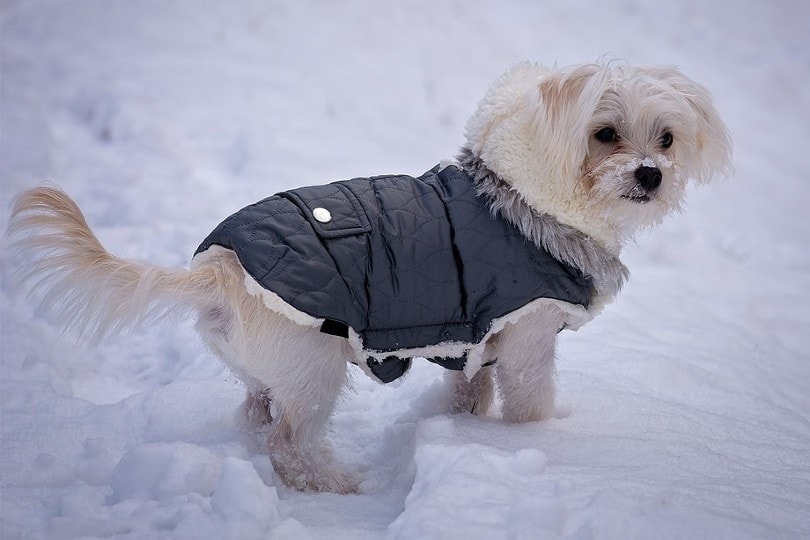How Do Dogs Feel the Cold? Facts & Care Tips

Updated on

Click to Skip Ahead
Dogs have coats and tolerate cold temperatures better than humans, but that doesn’t mean they don’t get cold or that it’s not dangerous for them in extreme temperatures.
Generally, small- or medium-sized dogs will feel the cold around 50°F, while larger dogs will feel the cold around 40°F. This can vary between the dog’s breed, coat, age, and other factors, however.
Factors That Affect Your Dog’s Cold Tolerance
All dog breeds descend from wolves, but selective breeding from humans has significantly altered their genetics and traits over the centuries. Some dogs are ideally suited for extremely cold temperatures, such as Alaskan Malamutes and Siberian Huskies, while others are suited to hot climates like Chihuahuas.
- Coat type: Dogs with thick, double-layered coats tend to be cold-tolerant and come from northern climates. Dogs with thin coats, like greyhounds and dachshunds, don’t have this insulation for extreme temperatures.
- Coat color: Dogs with dark coats absorb heat from sunlight when outdoors.
- Size: Small dogs lose heat faster than large dogs.
- Weight: Leaner dogs have less bulk to keep them warm.
- Conditioning: Dogs raised in colder climates are more adjusted to them than dogs from hot or temperate climates.
- Age and health: Puppies, senior dogs, and dogs with certain health conditions don’t regulate their body temperature well and get cold easily.
- Moisture: Bodies lose heat faster when wet, so rain, snow, or swimming can cause your dog to lose its body heat and feel cold.
- Wind: As humans, we know that the wind chill can make a mild day feel frigid, and it’s similar for dogs. Their coats only do so much, and strong winds can cut through a thick coat and make your dog feel cold.
- Overcast: A cloudy day will feel colder because of the lack of warmth from the sun.
- Activity: Exercise raises body temperature, which helps to keep your dog warm in cold temperatures.
How to Tell if Your Dog Is Cold
Generally, your dog will be more comfortable in the cold than you will be, but it’s important to pay attention to the temperature. If it’s below 40°F, it’s likely your dog will begin to feel chilly, and you should limit time playing or walking outside.
If the temperature is below 20°F, it’s unsafe for most breeds. Prolonged exposure to the cold could cause hypothermia, which can be life-threatening, or frostbite of your dog’s paws or ears. Severe frostbite may require surgery to remove dead tissue. In addition, dogs with heart disease, diabetes, or other health conditions with poor circulation are at greater risk of developing frostbite.
How to Keep Your Dog Warm in Cold Weather
If you live in a cold climate and you have to walk your dog in frigid temperatures, you can take some measures to protect your dog from hypothermia and frostbite.
- Limit outdoor time: Dogs are not meant to spend long periods of time outside, even if they’re Arctic breeds. The coat doesn’t cover everything, and their nose, paws, and ears are vulnerable to the cold. Keep your walks or outdoor playtime short.
- Dress them: Small or short-haired dogs, senior dogs, and puppies should have a sweater or coat to go outside in frigid temperatures. The time outdoors should still be short, but this can provide some extra protection from hypothermia.
- Don’t leave your dog in the car: Everyone knows not to leave a dog in a hot vehicle, but the same applies to cold weather. Cars can get chilly in cold temperatures, and though your dog may not get frostbite, it’s probably going to be uncomfortable.
- Know the warning signs: Hypothermia can be hard to spot. If you notice your dog has ice on its body, is whining or shivering, or stops moving, it’s time to go inside. Get your dog wrapped in a blanket and contact your vet. Frostbite can take longer to show, so monitor your dog’s ears, paws and paw pads, and tail for any changes.

Conclusion
Dogs tolerate the cold better than we do, but that doesn’t mean they don’t get chilly. In frigid temperatures, your dog could be susceptible to frostbite or hypothermia. Different breeds have different cold tolerances, and it’s important to keep small dogs, short-haired dogs, puppies, and senior or ill dogs protected when the cold winter weather hits.
See also:
- 10 Best Winter Coats & Jackets for Dogs – Reviews & Top Picks
- 10 Best Insulated Dog Houses for Winter – Reviews & Top Picks
Featured Photo Credit: Reimar, Shutterstock













